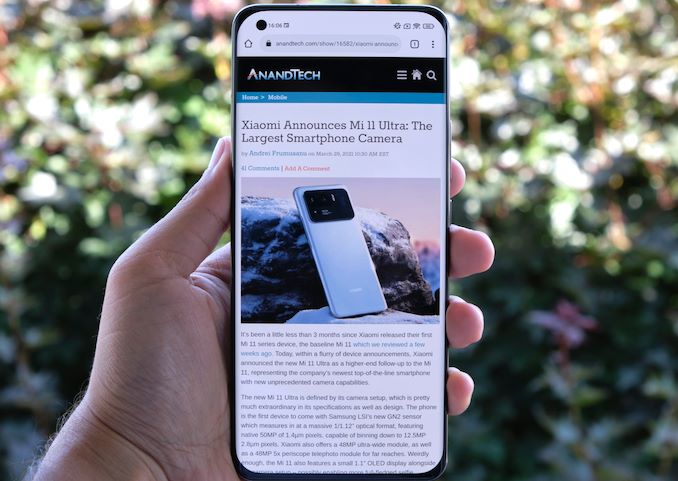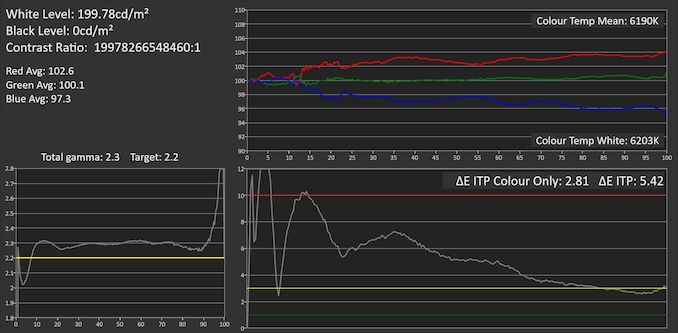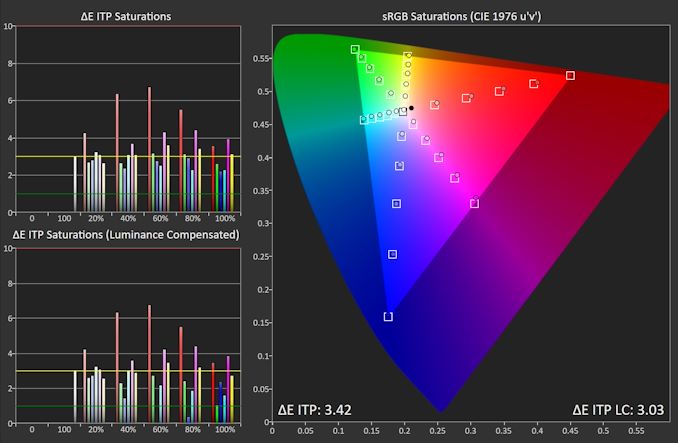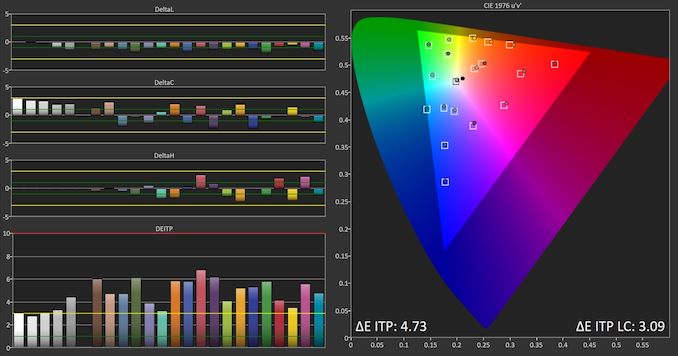The Xiaomi Mi 11 Ultra Review: Big and Fast, but Inefficient
by Andrei Frumusanu on July 20, 2021 9:00 AM EST- Posted in
- Mobile
- Smartphones
- Xiaomi
- Mi 11 Ultra
Display Measurement
The display of the Mi 11 Ultra is relatively quite straightforward: it’s the same one as on the Mi 11.
The 1440p OLED panel features 120Hz refresh rate, however lacks any kind of more advanced battery saving mechanism that are featured on newer generation panels such as on the Note20 Ultra, S21 Ultra, or claimed on the OnePlus 9 Pro. There is a coarse software-based refresh rate switching mechanisms but this only works at brightness levels above 110 nits.
In terms of colour management, the Mi 11 Ultra features the same complex and comprehensive display settings as on the Mi 11, which allows for extensive tuning and change the characteristics to one’s liking.
We move on to the display calibration and fundamental display measurements of the Xiaomi Mi 11 Ultra screen. As always, we thank X-Rite and SpecraCal, as our measurements are performed with an X-Rite i1Pro 2 spectrophotometer, with the exception of black levels which are measured with an i1Display Pro colorimeter. Data is collected and examined using Portrait Display's CalMAN software.

In terms of brightness, oddly enough I wasn’t able to have the Mi 11 Ultra to measure in as bright as the regular Mi 11, only reaching 747 nits in auto-brightness when under high ambient light. That’s a bit of an odd discrepancy, but generally the only one when it comes to the differences between the two devices.
In terms of greyscale accuracy, we’ve measured the calibration in the phone’s “original colour” mode which seemingly is the most accurate profile.
The results here are near identical in every way to what we measured on the Mi 11 – including all of the defects, such as too warm white tones, and a virtually identical gamma curve and greyscale inaccuracy error curve.
Saturation and gamut accuracy are also near the same as on the Mi 11, with the same slight deviations in the reds and magentas, and ending up with almost identical dETIP error values.
In the GretagMacbeth patches of commonly found tones such as skin tones, the Mi 11 Ultra is consistently inconsistent in how it behaves, as it matches what we’ve measured to the Mi 11 to a high degree. This includes tones being slightly too dark due to the higher gamma curve, and larger colour deviations in the reds.
Generally speaking, the Mi 11 Ultra screen is very much identical to the Mi 11 one, both in its strengths and weaknesses. Strengths are good brightness, contrast, resolution, and of course the 120Hz refresh rate. The weaknesses are still somewhat off colours, but which can be at least customized to taste thanks to Xiaomi’s extensive software controls.
It's more on the hardware side where the screen doesn’t do as well, lacking either the more advanced LTPO panels of the competition, nor seemingly featuring any newer generation and more efficient OLED emitter, which will impact the phone’s power efficiency.
















41 Comments
View All Comments
Silver5urfer - Tuesday, July 20, 2021 - link
That's really damn unfortunate.Samus - Wednesday, July 21, 2021 - link
It's really hard to review Sony phones here in the USA because it's hard to even get them. While AT is obviously a global-focused website, they aren't going to review products that aren't even sold in the USA, though there have been some exceptions such as Eurocom notebooks and Chinese-built reference design devices (that would become other products sold in the USA)I don't think Sony has sold a US-market phone since the Z3. That was like 5-6 years ago?
Andrei Frumusanu - Wednesday, July 21, 2021 - link
I'm based in Europe so that's not the primary reason, it's just that Sony isn't doing a great job and the current way the devices are, they're low priority.neothe0ne - Thursday, July 22, 2021 - link
This comment is complete FUD. Sony has sold US model phones the entire time. In the past, they had specifically disabled the side-mounted fingerprint sensors, only for devices sold in the US, because of Apple patents. (The fingerprint sensor is now enabled in the US for several generations already.)Oxford Guy - Tuesday, July 20, 2021 - link
I think it’s droll how bloated phones have become, such as overkill screen specs. I keep my phone in greyscale most of the time, as it’s much more pleasant versus a sea of clashing garish/oversaturated color.So, 10-bit panels are certainly not at the top of my list.
For photography, I have two proper cameras — a Sigma for color-critical shots and a Nikon for the big zoom. Real cameras are vastly more suited to anything beyond very mundane photography. The Sigma isn’t a large camera at all. It could be better (battery life, macro ability, night shots, fast shots/shakiness) but I’d rather have it than any phone for most things. For ‘quick and dirty but still good quality’ I have the Nikon.
heffeque - Tuesday, July 20, 2021 - link
Why are you complaining about a phone that is clearly not for you?What are you going to complain about next? Maybe that there are no 15" screen versions of the phone for people that want extra-large screens?
Wereweeb - Tuesday, July 20, 2021 - link
He's complaining about the general direction that the smartphone industry has been heading to, not about this phone in particular. There's no choice to buy a phone without a camera.I personally sympathize with his woes on the lack of choice, but economies of scale dictates that companies must chase after the abstract "general consumer".
Oxford Guy - Wednesday, July 21, 2021 - link
I’m not sure what tales of woe you detected in my post.The main gist is that superfluous spec chasing doesn’t impress me. Putting fingerprints onto an ultra-fancy screen and dealing with the terrible ergonomics of camera phones — both seem to be examples of diminishing returns taken a bit too far.
Perhaps phones really need 10-bit color but I don’t see the need for it.
Wereweeb - Tuesday, July 20, 2021 - link
The overwhelming majority of people don't care about professional cameras or "colour critical photography", they want to be able to take photos without having to plan or think about it.And the Mi 11 Ultra is a great step forward over your typical smartphone camera, at least in terms of hardware. Now they just need to make >100mm² sensors more affordable.
Wereweeb - Tuesday, July 20, 2021 - link
Think about it like this: the mass-production of sensors and development of algorithms that can extract more information from the same sensor means that there will be improvements for you DSLR people as well